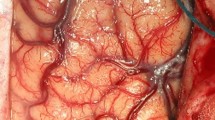Summary
A series of 12 patients with tectal plate gliomas, is presented treated by direct surgery. Mean age was 19 years. All patients presented with signs of raised intracranial pressure and supratentorial hydrocephalus on CT scan. Diplopia was the most common local sign. CT scan and MR imaging showed 4 intrinsic, 6 exophytic, and 2 ventrally infiltrating tectal tumours. The histological diagnosis was low-grade astrocytoma in 7, high-grade astrocytoma in 2, oligodendroglioma in one, oligo-astrocytoma in one, and ependymoma in one case.
The suboccipital supra- and transtentorial approach was used in every cases. Tumour resection was generous at the level of the superior colliculi, but on the contrary, resection was limited at the level of inferior colliculi due to the auditory risk. Tumour removal was total (macroscopically) in 9 cases and partial in 3 cases.
There were 4 surgical complications and one death related to surgery. Parinaud's syndrome was the most-common postoperative sequelae. Auditory hallucinations and the acoustic neglect syndrome were seen once. In three cases additional radiotherapy and chemotherapy were given once with severe sequelae.
The treatment of tectal plate gliomas is controversial. The role of different therapeutic options remains open. We consider the tectal plate as a relatively safer territory for surgery than the ventral part of the midbrain. The brain stem auditory evoked potentials (BAEPs) and middle latency potentials (MLPs) monitoring can help to determine the appropriate limit of surgery.
Similar content being viewed by others
References
Aitkin LM, Phillips SC (1984) Is the inferior colliculus an obligatory relay in the cat auditory system? Neurosci Lett 44: 259–264
Bravo G, Vaquero J, Martinez R, Cabezudo J (1981) Conservative management of a mesencephalic tuberculoma. J Neurosurg 55: 287–288
Bruno L, Schut L (1982) Survey of pediatric brain tumors. In: American Association of the developing nervous system. Grune and Stratton, New York
Caird DM, Klinke R (1987) The effect of inferior colliculus lesions on auditory evoked potentials. Electroencephalogr Clin Neurophysiol 68: 237–240
Chapman PH (1989) Indolent gliomas of the midbrain tectum. In: Marlin AE (ed) Concepts in pediatric neurosurgery, Vol 10. Karger, Basel, pp 97–107
Coffey RJ, Lunsford LD (1985) Stereotactic surgery for mass lesions of the midbrain and pons. Neurosurgery 17: 12–18
De Angelis LM (1981) Intracranial tuberculomas: case report and review of the literature. Neurology 31: 1133–1136
Dierssen G, Trigueros F, Sanz F, Coca JM, Orozco M (1978) Surgical treatment of a mesencephalic tuberculoma. J Neurosurg 49: 753–755
Epstein F, McCleary EL (1986) Intrinsic brain-stem tumors of childhood: surgical indications. J Neurosurg 64: 11–15
Farwell JR, Dohrmann Gj, Flannery JT (1977) Central nervous system tumors in children. Cancer 40: 3123–3132
Flamm ES, Rovit RL, Kricheff II,et al (1972) Periaqueductal neoplasms and vascular malformations. NY State J Med 72: 2623–2628
Goldberg JM, Moore RY (1967) Ascending projections of the lateral lemniscus in the cat and monkey. J Comp Neurol 129: 143–156
Golden GS, Ghatak NR, Hirano A,et al (1972) Malignant gliomas of the brain-stem. A clinicopathological analysis of 13 cases. J Neurol Neurosurg Psychiatry 35: 732–738
Hashimoto I, Ishiyama Y, Yoshimoto T (1981) Brainstem auditory evoked potentials recorded directly from human brainstem and thalamus. Brain 104: 841–859
Hatcher MA Jr, Klintworth GK (1966) The Sylvian aqueduct syndrome. A clinicopathologic study. Arch Neurol 15: 215–233
Kernohan WJ, Sayre GP (1952) Tumors of the central nervous system. Atlas of tumor pathology, Section X, Fascicle 35. Armed Forces Institute of Pathology, Washington, DC, pp 19–42
Hoffman HJ, Becker L, Craven MA (1980) A clinically and pathologically distinct group of benign brain stem gliomas. Neurosurgery 7: 243–248
Koos WT, Miller MH (1971) Intracranial tumors of infants and children. Mosby, St. Louis, pp 346–350
Lapras Cl, Patet JD, Mottolese C, Lapras Ch (1987) Direct surgery for pineal tumors: occipital transtentorial approach. Prog Exp Tumor Res 30: 268–280
Matson DD (1969) Neurosurgery of infancy and childhood, 2nd Ed. Thomas, Springfield, Ill
May PL, Blaser SI (1991) Benign intrinsic tectal “tumors” in children. J Neurosurg 74: 867–871
Moore JK (1987) The human auditory brainstem: a compartive view hear. Research 29: 1–32
Nauta HJW, Contreras FL, Weiner RL, Crofford MJ (1987) Brainstem abscess managed with computer tomography-guided stereotactic aspiration. Neurosurgery 20: 476–480
Neuwelt EA, Gumerlock MK (1984) The challenge of pineal region tumors. In: Neuwelt EA (ed) Diagnosis and treatment of pineal region tumors. Williams and Wilkins, Baltimore
Nieuwenhuys R, Voogd J, Van Huijzen C (1978) The human central nervous system. Springer, Berlin Heidelberg New York, pp 121–135
Pendl G (1984) Microsurgical anatomy of the pineal region. In: Neuwelt EA (ed) Diagnostic and treatment of pineal region tumors. Williams and Wilkins, Baltimore, pp 155–207
Pendl G, Vorkapic P, Koniyama M (1990) Microsurgery of midbrain lesions. Neurosurgery 26: 641–648
Petit-Dutaillis D, Thiebaut F, Berdet H,et al (1950) A propos de sténoses de l'aqueduc de sylvius d'origine non tumorale de l'adolescent et l'adulte. Rev Neurol 82: 417–421
Raffel C, Hudgins R, Edwards MSB (1988) Symptomatic hydrocephalus: initial findings in brainstem gliomas not detected on computed tomography scans. Pediatrics 82: 733–737
Reigel DH, Scarff TB, Woodford JE (1979) Biopsy of pediatric brainstem tumors. Childs Brain 5: 329–340
Sanford RA, Bebin J, Smith RW (1982) Pencil gliomas of the aqueduct of Sylivus. Report of two cases. J Neurosurg 57: 690–696
Steinbok P, Boyd CM (1987) Periaqueductal tumor as a cause of late-onset aqueductal stenosis. Childs Nerv Syst 3: 170–174
Stroink AR, Hoffman HJ, Hendrick EB,et al (1986) Diagnosis and management of pediatric brainstem gliomas. J Neurosurg 65: 745–750
Yamamoto I, Kageyama N (1980) Microsurgical anatomy of the pineal region. J Neurosurg 53: 205–221
Weber G (1974) Midbrain tumors. In: Vinken PJ, Bruyn GW (eds) Handbook of clinical neurology, Vol 17. North Holland, Amsterdam, pp 620–647
Author information
Authors and Affiliations
Rights and permissions
About this article
Cite this article
Lapras, C., Bognar, L., Turjman, F. et al. Tectal plate gliomas. Part I: Microsurgery of the tectal plate gliomas. Acta neurochir 126, 76–83 (1994). https://doi.org/10.1007/BF01476414
Issue Date:
DOI: https://doi.org/10.1007/BF01476414




